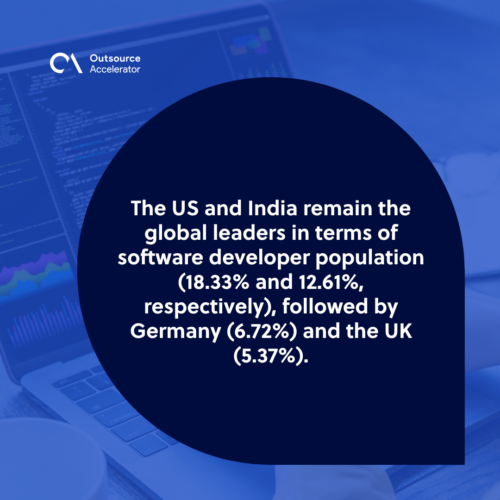Software developer statistics you should know in 2025

Software developer statistics you should know in 2025
“The global number of software developers is foreseen to reach 28.7 million by 2024″
– Source Statista
“The software market revenue is expected to reach USD 650 million in 2023”
– Source Statista
“India is projected to replace the US as the country with the highest number of software developers by 2024”
– Source Evans Data
“The software development industry is dominated by men (91.88%), while the minority is comprised of women (5.17%) and non-binary, genderqueer, or non-conforming (1.67%)”
– Source Statista
“JavaScript remains the favored programming language globally (65%), followed by HTML/CSS (55.08%), SQL (49.43%), Python (48.07%), and TypeScript (34.83%)”
– Source Statista
“29% of software developers worldwide have spent between five to nine years coding, while 19% have about one to four years of experience”
– Source Statista
“The US and India remain the global leaders in terms of software developer population (18.33% and 12.61%, respectively), followed by Germany (6.72%) and the UK (5.37%).”
– Source Stack Overflow
Keeping up to date with the latest developments in business and technology is critical for companies. For tech-reliant businesses – or software specialists looking for employment opportunities – remaining abreast of the most recent software developer statistics is a must.
This article will look at the latest trends in software developer statistics and their implications for businesses and professionals. From salary trends to specific demographics, we’ll tackle everything relating to software developer statistics.
Read on below to start learning about developments you can’t miss!
Software developer statistics overview
- According to Statista, the global number of software developers is foreseen to reach 28.7 million by 2024.
- The software market revenue is expected to reach USD 650 million in 2023.
- Evans Data, a software development trends research firm, projects that India will replace the US as the country with the highest number of software developers by 2024.
- Evans Data’s Global Developer Population and Demographics study showed that the Asia-Pacific Region has the strongest growth in terms of software developer population, followed by the Latin American region.
- The software development industry is dominated by men (91.88%), while the minority is comprised of women (5.17%) and non-binary, genderqueer, or non-conforming (1.67%).
- The global average age of employed software developers is between 25 and 34 years old. This is younger than the US average of 39 years old.
- JavaScript remains the favored programming language globally (65%), followed by HTML/CSS (55.08%), SQL (49.43%), Python (48.07%), and TypeScript (34.83%).
- 29% of software developers worldwide have spent between five to nine years coding, while 19% have about one to four years of experience. Less than one percent (0.34%) of the world’s developers have over 50 years of experience, while 2% have less than a year.
- According to PayScale, software developers in the Philippines have an average annual salary of Php 365,125. Meanwhile, Glassdoor pegs their US counterpart’s yearly salary at USD 95,282.
- The most-used web framework among global software developers is Node.js (47.12%), followed by React.js (42.62%), jQuery (28.57%), Express (22.99%), and Angular (20.39%).

Software developer statistics: The demographics
The previous section presented some of the top trends in software developer statistics from the previous year and projections for this one.
This section will explore the implications of these statistics – how these figures might affect businesses and software developers.
Software developer statistics: Gender disparity
Statista’s 2022 software developer gender distribution study revealed the field to be overwhelmingly male (almost 92%). In the US – the present global leader in software developer employment – men comprise 76% of the total workforce.
This demonstrates an imbalanced ratio of representation in the industry, with the vast majority of developers being male. The disparity can be a cause for concern, as it implies gender-based barriers to entry, limiting opportunities for those who are not men.
The sector’s lack of diversity can mean two things. For one, the industry is missing out on the immense talent that women can bring to the table. It also means that the products and services that are created are not reflective of the diverse needs of the population.
Software developer statistics: Age range
The global average age of employed software developers is between 25 and 34 (39.52%), while developers ages 18 to 24 make up 25.47%.
Older developers comprise the remaining age minorities, with those between 35 and 44 accounting for 18.42%, 45 to 54-year-olds for 6.64%, and 65 years and older at less than 1%. There are also developers younger than 18, who make up 6.52% of the sector.
This age range can be an implication of two things:
- Software development is a relatively young profession.
- It is both attractive and accessible to younger generations.
The fact that the average age is so low speaks to the accessibility (age-wise, as implied by the gender distribution statistics) of the profession.
In addition, the relatively young age of software developers could be due to the ever-changing nature of the profession. As technology advances, so too do the skills required to be a successful software developer.
This means that those who have been working in the field for a longer period of time may have the same level of knowledge and experience as those who are just beginning their career. Thus, younger developers are often leading the way in terms of advancements in software development.

Software developer statistics: Geographic distribution
The bulk of the world’s software developer population (60%) is distributed across ten countries. The US and India remain the global leaders in terms of software developer population (18.33% and 12.61%, respectively), followed by Germany (6.72%) and the UK (5.37%).
These statistics highlight the fact that the vast majority of software developers are concentrated in a relatively small number of countries. The distribution is likely because these countries have the necessary infrastructure and resources to support a flourishing software development industry.
Additionally, these numbers may be indicators of these countries’ strong educational systems, economic stability, and access to capital and resources that can facilitate software development.
It may also reflect the global digital divide, where countries with higher levels of development have access to more resources. In comparison, countries with lower levels of development may struggle to produce enough software developers.

Software developer statistics in various industries
Software developers are a crucial part of the tech industry. These tech specialists are responsible for creating various computer programs and mobile and web applications that power many technologies in numerous other sectors.
As such, it doesn’t come as a surprise that software developers are in demand in the tech industry and other sectors, such as healthcare, e-commerce, and finance.
Below are some interesting software developer statistics from different industries:
Software developers in healthcare
Software developers play a vital role in the healthcare industry. They are responsible for designing, coding, and maintaining software that helps healthcare professionals perform their jobs more effectively and efficiently.
Some examples of software tools used in healthcare are:
- Electronic health records
- Hospital management systems
- E-prescription software
- Medical database software
Aside from designing and coding applications, software developers also troubleshoot and repair any technical issues that may arise. This requires a strong understanding of healthcare software’s inner workings and a keen eye for potential problems.
Software developers in e-commerce
Software developers play an increasingly important role in the e-commerce industry. With online shopping’s surge in popularity, businesses need developers to build and maintain their websites and applications and create innovative solutions for a better customer experience.
Below are some aspects of the e-commerce sector where software developers help.
- UI/UX improvement
- Designing, testing, and implementing new features
- Website and application development
- Website and application maintenance
Overall, software developers are vital to the success of an e-commerce business. They provide the technical expertise that is necessary to build and maintain an effective online presence and drive sales. Without them, businesses would be unable to keep up with the ever-evolving digital landscape.
Software developers in financial services
Software developers’ expertise and technical knowledge are essential for the success of any financial institution. By leveraging technology, they ensure that financial services companies can provide the best possible services to their customers.
These professionals are responsible for the following services:
- Creating and maintaining software that helps with data tracking, accounts management, and payment processing
- Developing and maintaining databases
- Conducting system analysis to detect potential problems and improve security
- Automating mundane tasks, such as data entry
- Creating models to help analyze, identify, and predict trends
In a rapidly changing world, software developers are the ones driving the financial services industry forward.
They are the ones creating the solutions that allow companies to stay ahead of the latest trends and remain profitable. Without them, the financial services industry would not be where it is today.
How can these software developer statistics help your business?
Learning more about software developer statistics can be invaluable to businesses for several reasons. For one, it gives company owners a better grasp of the sector’s current state that they can use to their advantage.
Another reason is it gives them a better understanding of the average salary of software developers in certain areas. This knowledge can help businesses set appropriate compensation rates when recruiting new talent.
Similarly, knowing the most popular technologies and programming languages can help companies decide which technology to adopt for their software projects.
Learning more about software developer statistics can also help companies to identify potential areas of improvement. They will be able to allocate resources more effectively to maximize their return on investment.
Ultimately, having a better understanding of software developer statistics helps businesses make informed decisions, remain competitive, and maximize profits.







 Independent
Independent




